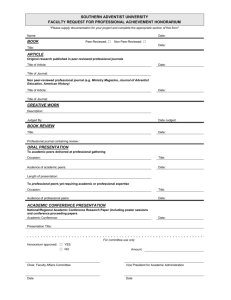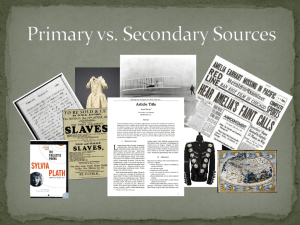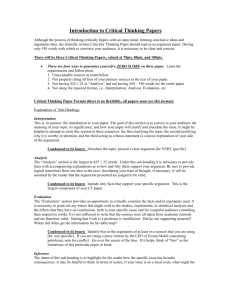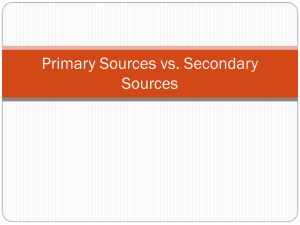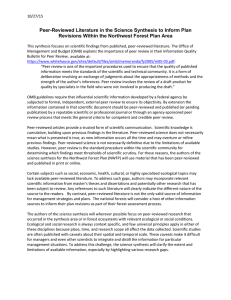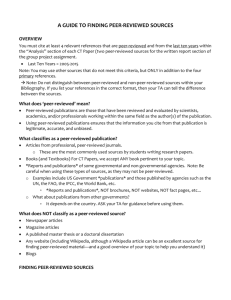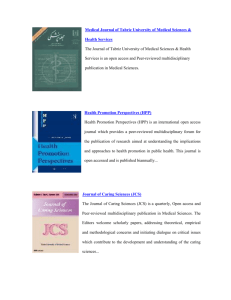Primary vs. Secondary Sources
advertisement
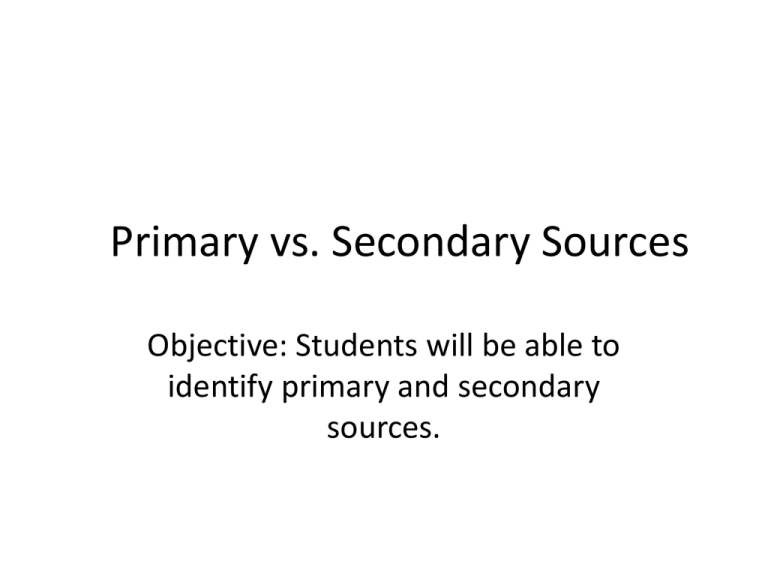
Primary vs. Secondary Sources Objective: Students will be able to identify primary and secondary sources. Primary Sources • Primary sources are the original sources of information recorded at the time an event occurred. – First-hand accounts of events – Data collected for scientific studies – Historical documents Primary Sources • Primary sources can also be written well after events. - memoirs - oral histories Why use primary sources? • To explain how major events are related to each other in time. • To think critically and distinguish between fact and opinion. • To recognize point of view in print and visual materials. Why use primary sources? • To develop your own conclusions and analyze how historical events affect your life. • To recognize failures and successes in the past in order to make better decisions as a citizen. • To understand who you are by examining your roots or placing yourself in that time period or situation. Primary Source Examples • • • • • • • • Diaries Poetry Personal Interviews Government Documents Autobiographies Peer-reviewed Journal Articles Photographs Artifacts/Ephemera Examples of Primary Sources: •Baseball Cards •Photos •Editorial Cartoons Finding Primary Sources • Use the library catalog • Ask your librarian • Search article databases and limit to primary sources or peer-reviewed • Search Google Books Finding Primary Sources Some databases will let you limit to Primary Sources. Find Primary Sources And many peer-reviewed journal articles are also considered primary sources because their authors collected data, analyzed it, and wrote up their original results in a paper. Many databases let you limit your search to peer-reviewed or scholarly articles. Peer-reviewed Journal Article First Page of the Article showing the Abstract Article Record The schools the authors are affiliated with Finding Primary Sources To find primary documents on the web, try the following internet search topic + “primary source” Secondary Sources • Secondary sources of information are derived from primary sources – Summaries of primary sources – Analyses or interpretations of primary sources Why use secondary sources? • To get expert opinions in order to evaluate what really happened. • To gain insight by examining the same event from different perspectives. • To form our own opinions. • To save time by reading information collected from a number of different sources. Secondary Source Examples • • • • • Dictionaries Encyclopedias Textbooks Articles that review other sources Biographies Examples of Secondary Sources: •Biographies •Textbooks •Encyclopedias Finding Secondary Sources • • • • Use the library catalog Ask the librarian Use article databases Search Google Books Secondary Source Example The image on the right shows a snippet of a review of the book Lies My Teacher Told Me. Book reviews are secondary sources. Both Primary and Secondary sources may have a slant or bias You need to look at both primary and secondary sources critically to see if they are promoting a particular point of view or showing both sides of an issue. Bias can also show up by what is left out, as much as by what is left in. Primary Source Bias Example: John Adams Personal Papers In his personal letters to Thomas Jefferson, John Adams viewed his role in the creation of the Declaration of Independence as central. But, Thomas Jefferson, as the primary author of the document, gets much of the credit in history textbooks. Secondary Source Bias Example: History Textbooks A history textbook is a secondary source. Because there is so much history to cover, much of what is discussed shows the positives and not the negatives. The author of Lies My Teacher Told Me provides less flattering, although factual, portraits of some individuals who have played significant roles in the history of the United States. Reading Sources Ask these basic questions about every source, no matter how obvious the answer might seem. – – – – – Who wrote this? What does it say? When was it written? Where was it written? Why was it written? Summing Up It is important to determine the type of information you are looking at. – Primary sources are original sources of information – Secondary sources summarize, analyze, or critique primary sources – Both primary and secondary sources can be good sources of information, but you need to critically evaluate them. Matching Review Game Primary Secondary Letters Memoirs Personal Interviews Photographs Artifacts or Objects Manuscripts Diaries Original Research Data Articles that review other sources Biographies Textbooks Government Documents Encyclopedias or Dictionaries Newspaper First Hand Reports Journals Audio Recordings Moving Pictures or Video Autobiographies Speeches Poetry Peer-reviewed journal articles Newspaper Editorials
